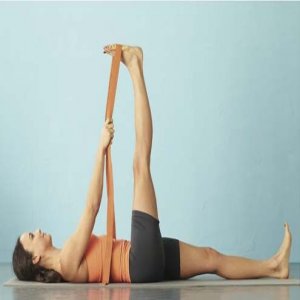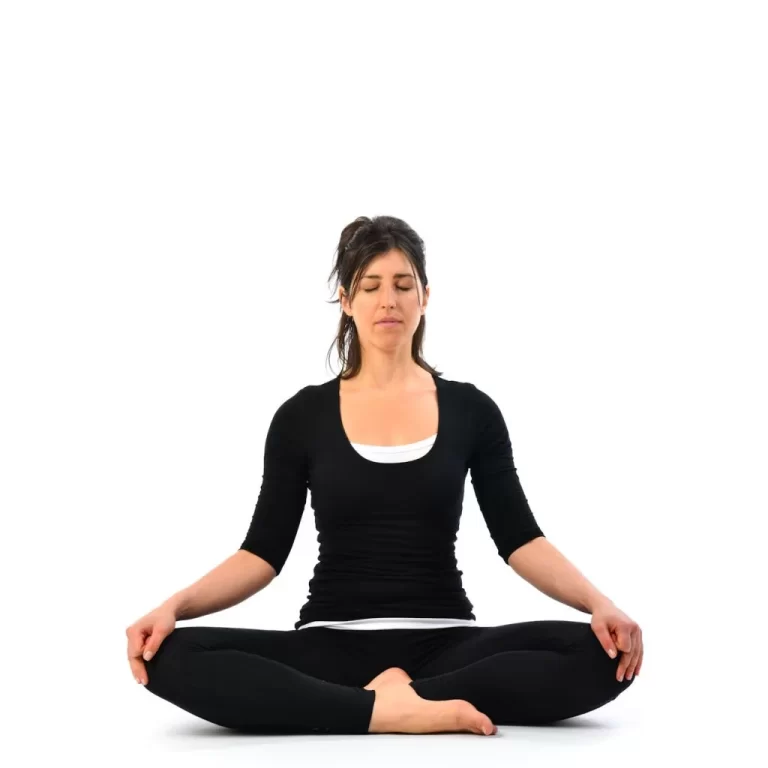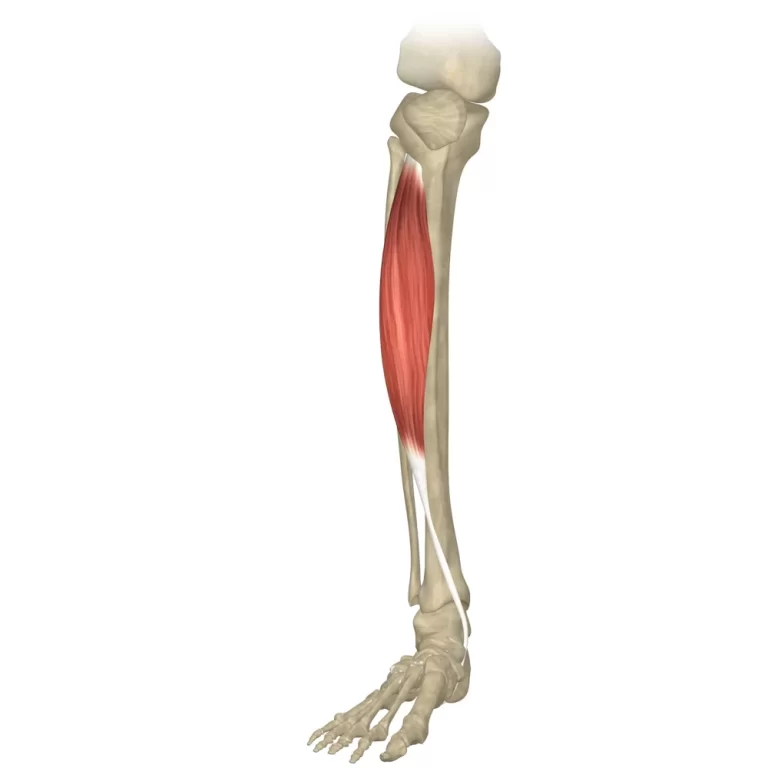17 Best Exercise for Bicipital Tendonitis
Introduction:
Exercise for Bicipital Tendonitis is an important part of your treatment plan. Biceps tendinitis is a cause of shoulder pain. There are exercises that can help reduce the level of pain of bicipital tendinitis. while the injury is healing you may perform exercises to keep your shoulder muscles strong. Exercise can help speed up your recovery and help with the healing process faster.
Exercise restores strength in your injured tendon. Exercise programs gain confidence and coordination in your daily activity life. in physical therapy, exercises can improve mobility, reduce pain, and allow you to go back to normal life. This exercise can help in relieving the symptoms and improve overall strength and flexibility.
What is a Bicipital Tendonitis?
Bicipital tendonitis, also known as biceps tendonitis, is a condition characterized by inflammation or irritation of the biceps tendon. The biceps tendon connects the biceps muscle to the shoulder and elbow joints, allowing for arm movement and stability. Bicipital tendonitis often occurs due to overuse, repetitive motions, or sudden injury, and it is commonly seen in athletes, weightlifters, and individuals who engage in repetitive arm movements.
Benefits of exercise for Bicipital Tendonitis:
If you are doing regular exercise, then here are the benefits,
- Reduce inflammation
- Increases muscle strength
- Improve your daily activity function
- Muscle relaxation
- Improve posture
- reduce tightness
- Restore mobility
- Improving coordination
- Improve physical fitness
- Increased range of motion
- Prevent further progression of the injury
- Better quality of life
The Best Exercise for Biceps Tendonitis:
Following are the best exercises that really helpful to you for bicipital tendinitis,
Biceps curls
- Start with a relaxing standing position.
- Now grab a lightweight like dumbells in your hand.
- Keep your arms palm facing forward.
- Then keep your upper arm straight.
- Then lift the weight at your elbow.
- Hold for a few seconds.
- Slowly lower your arm back down.
- Then return to your neutral position.
- Then relax.
- Do this 10 times repeat in a day.

Shoulder flexion
- Start with a relaxing standing or supine position.
- Keep your arm at your side and your palm facing your thigh.
- Now slowly raise your arm up.
- The arm is straight until your fingers are pointed up.
- Hold this position for a few seconds.
- Then return to your neutral position.
- Then relax.
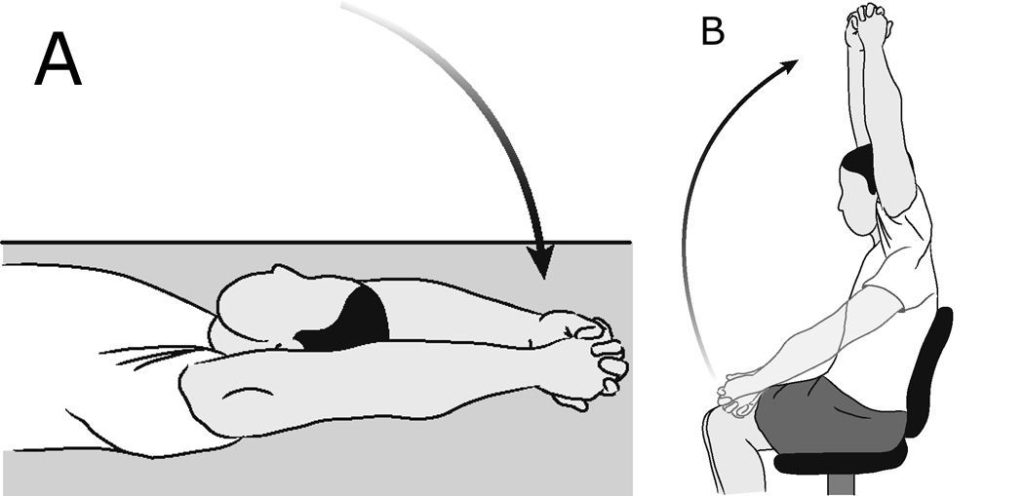
Biceps stretch
- Start with relaxing standing face a wall and about 6 inches away stand.
- Now your palm down and raise the arm on your injured side and try to touch the thumb side of your hand to the wall.
- Keep sure your arm is straight.
- Then turn your body far from your lifted arm until you feel a stretch in your muscles.
- Hold this stretch for a few seconds.
- Then return to your neutral position.
- Then relax.
- Do this 10 times repeat in a day.
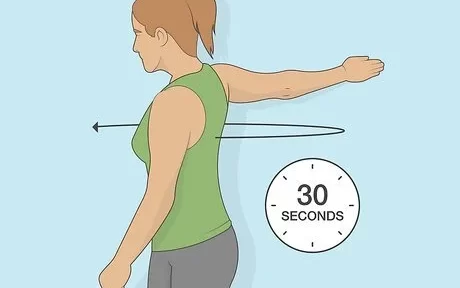
Resisted internal rotation
- Start with the relaxing standing position.
- Now attach the band to a door or some other object and face it.
- Then grasp the resistance band in the hand of your arm.
- Keep your elbows at a 90-degree angle position.
- Then move back the forearm inward of the body.
- Then slowly return to your neutral position.
- Then relax.
- Repeat on the other side.
- Repeat 5-10 times.

Resisted external rotation
Start with the relaxed standing position.
Now place a mini resistance band around your wrists.
Keep your elbows at a 90-degree angle position.
Spread your wrists outward into the band.
Hold this position for a few seconds.
Then slowly return to your neutral position.
Then relax.
Repeat 5-10 times.
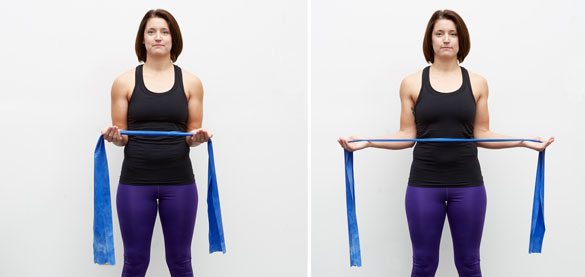
Elbow flexion
- Start with a relaxing standing position on the ground.
- Now your forearm up and smoothly bends your elbow to its comfortable position.
- Hold this position for a few seconds.
- Then lower your forearms down.
- Then return to your neutral position.
- Then relax.
- Repeat 5-10 times.
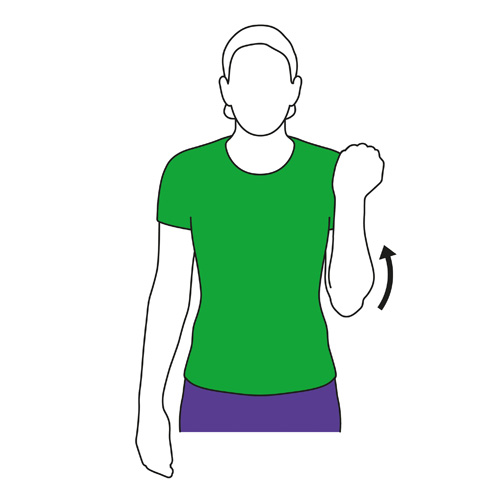
Side-lying external rotation
- Start with a relaxed side-lying position on the bed.
- Now extend your other arm along the bed and rest your head against it.
- Bend your knees for comfort and stability.
- Then bend your elbow 90 degrees and your palm facing toward your body.
- Then lower your arm down toward the bed.
- Raise your forearm to a comfortable position.
- Slowly lower down your forearm.
- Hold this position for a few seconds.
- Then return to your neutral position.
- Then relax.
- Do this 10 times repeat in a day.
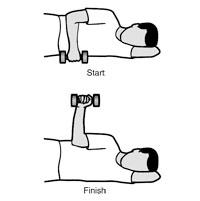
Sleeper stretch
- Start with a relaxed side-lying position with the affected shoulder under you and your arm bent.
- Then use your other hand to push your forearm down to the floor.
- Press as far down until you feel a gentle stretch in the back of your shoulder till the comfortable position.
- Hold it for a few seconds.
- Then return to your neutral position.
- Then relax.
- Repeat on the other side.
- Repeat 5-10 times.

Forearm Supination and Pronation
- Start with a relaxed seating position on the table or chair.
- Keep your arms by your side.
- For resistance, you can use a dumbbell lightweight.
- Turn your hands over so that your palms are now facing up.
- Hold for 5 seconds.
- Then slowly return to your neutral position.
- Then relax.
- Now move your arm out palm facing down.
- Hold for 5 seconds.
- Then slowly return to your neutral position.
- Then relax.
- Repeat 5-10 times.
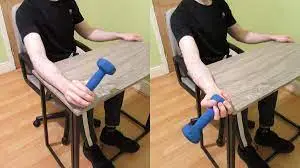
Isometric elbow flexion
Start with a relaxing seating position.
Put your forearm hand on the table.
Your palm hand facing upward position.
While resisting with the top hand you try to bend the elbow of your arm.
Do not allow your elbow to move.
Hold for 10 seconds.
Then slowly return to your neutral position.
Then relax.
Repeat 5-10 times.

Standing Row
- Start with a relaxed standing position on the floor.
- Now place a resistance band in a door or around a stable object.
- You can hold the end of the resistance band in both hands.
- Keep the elbows bent at 90 degrees.
- Your palms are facing each other.
- Then squeeze your shoulder blades together.
- While bringing the elbows back behind you.
- Hold this position for a few seconds.
- Then return to your neutral position slowly.
- Then relax.
- Repeat 5-10 times.
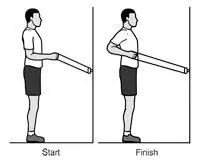
Band Seated Row
- Start with relaxing and sitting at the table.
- Keep your legs fully extended.
- Keep your back straight.
- Place the resistance theraband around the soles of the feet.
- Then hold one end in each hand.
- Now pull the band toward your waist.
- While squeezing the shoulder blades.
- Then slowly return to your neutral position.
- Then relax.
- Repeat 5-10 times.

Resistant Shoulder Flexion
- Start with a relaxing standing position on the ground.
- Now you can hold the rubber band or theraband.
- Slowly raise your arm overhead as far as to the comfortable position.
- Hold this position for 10-15 seconds.
- Then return to the starting position.
- Then relax.
- Repeat the exercise 5-10 times.
Active Resisted Elbow Flexion
- Start with a relaxing standing position on the ground.
- Theraband wrapped around your feet.
- Hold the end handle of resisted theraband in your arms.
- Now bend your elbow to a comfortable position.
- Then lower slowly.
- Hold this position for a few seconds.
- Then slowly return to your neutral position.
- Then relax.
- Repeat 5-10 times.
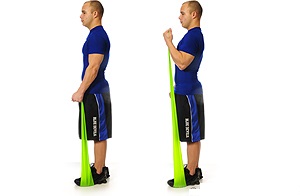
Wand Flexion Overhead
- Start with a relaxing standing position on the ground.
- Use any lightweight and rigid object like a wand stick to hold in both hands.
- Then raise the wand to its comfortable position.
- Hold this position for a few seconds.
- Then slow down.
- Then slowly return to your neutral position.
- Then relax.
- Repeat 5-10 times.

Prone Shoulder Horizontal Abduction
- Start with a relaxing prone position on the table or bed.
- Now the painful arm hanging off of a table or bed.
- You can use lightweight dumbell.
- Then raise the straight arm directly out towards your side.
- Squeeze the shoulder blade while you raise the straight arm.
- Hold this position for a few seconds.
- Then lower slowly.
- Then slowly return to your neutral position.
- Then relax.
- Repeat 5-10 times.

Shoulder internal rotation
- Star with a relaxing standing position against the wall.
- Now take a towel and drape it over your good shoulder.
- Then reach behind your back and hold the other end of the towel.
- With your top hand pull the towel straight up till the comfortable position.
- Then back your hand comes up towards your shoulder blade.
- Hold this position for a few seconds.
- Then slowly return to your neutral position.
- Then relax.
- Repeat 5-10 times.
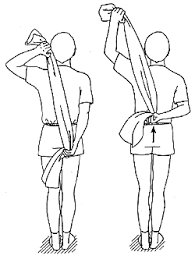
What precautions are required during exercises?
- Take rest between exercise
- Do slightly stretch and bend
- If your pain increase, stop immediately.
- Maintain good posture while performing exercises.
- To perform the gentle exercise with no pain.
When do you not perform the exercise?
- Severe muscle burning.
- Swelling or pain at joints.
- You’re feeling sick.
- If you feel any pain or numbness.
- Fever
- Headache
- If Exercise is painful stop the exercise
What exercises should you avoid with bicipital tendinitis?
- While your injury heals avoid overhead lifting movements.
- Repetitive more overhead movements.
- heavy lifting
- Repetitive shoulder use
- Sports activities like throwing and catching
FAQs
What is the best exercise for bicipital tendinitis?
Stretching, strengthening, balance, and range of motion exercises are the best exercises.
The best exercises for bicipital tendinitis like, shoulder flexion, sleeper, biceps stretch, internal and external rotation, and biceps curls.
How often should someone with bicipital tendinitis exercise?
The exercises for the rotator cuff and stability can be done daily for a minimum of 45 minutes. you will get benefit from a gentle daily exercise routine.
What are the exercises To Prevent Biceps Tendonitis?
To prevent biceps tendinitis, it’s important to do Flexibility Exercises, stretching, Strength & Stability Exercises, and a regular workout to build strength and flexibility.
What should you avoid with bicep tendonitis?
Avoid heavy lifting and overhead more repetitive movements of joints.
Does exercise help bicep tendonitis?
Gentle exercises can help speed up your recovery and help with the healing process.
What movements hurt with bicep tendonitis?
You can feel pain when you move the upper part of your arm due to weakness.


